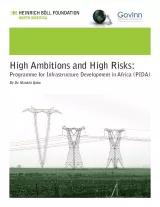High Ambitions and High Risks: Programme for Infrastructure Development in Africa (PIDA)
Overview:
According to the World Bank’s claim, Africa’s infrastructure funding gap is $93 billion per year until 2020, and 40% of this is for power needs. Of this total, about $66 billion per year represents Sub-Saharan Africa’s funding gap until 2020. Africa can bridge this gap if it doubles its spending on infrastructure (investment plus operations and maintenance) to about 15% of the continental GDP. Importantly, if Africa recovers the approximately $50 billion in illicit financial flows that leave the continent each year, it would go a long way toward financing its broader development agenda.
In justifying a major expansion in spending, a World Bank’s study, “Infrastructure: A Time for Transformation”, conducted in 24 African countries, estimates that the poor state of infrastructure in Sub-Saharan Africa cuts national economic growth by 2 percentage points every year and reduces business productivity by as much as 40 percent. Accordingly, infrastructure improvements are associated with increased economic growth rate, and with little consideration of negative environmental and other externalities.
African Leaders support the recommended scaling-up of infrastructure development and called for the creation of the Programme for Infrastructure Development in Africa (PIDA), as the blueprint for the continent. This programme weaves together two plans: the New Economic Partnership for Africa’s Development (NEPAD) and the Infrastructure Master Plan of the African Union (AU) in a single, inter-regional, and overarching framework for infrastructure development for Africa.
In 2012, African Heads of State adopted PIDA as a strategic framework that will run through 2040 in order to develop continental (cross-border) infrastructure (Energy, Transport, Information and Communication Technologies (ICT) and Trans-boundary Water Resources). PIDA’s main purpose is to strengthen the consensus and ownership of large cross-border infrastructure project that integrate energy, transportation, and water development on a continental scale.
PIDA is spearheaded by three pivotal African institutions: the African Union Commission (AUC), the New Partnership for Africa’s Development Planning and Coordination Agency (NEPAD Agency), and the African Development Bank (AfDB).
PIDA’s projects are estimated at $360 billion up to 2040. For its 51 priority action projects (PAP), the cost estimate stands at $68 billion from 2012 to 2020, or $7.5 billion in expenditure per year. Since PIDA spending represents about 17% of the anticipated $45 billion annual increase in infrastructure spending, the manner in which it complements other infrastructure spending on the continent is critical. Part 3 of this paper sets out PIDA’s Priority Action Plan of 51 infrastructure projects.
PIDA is also intended to support economic integration of Africa and its nine regional economic communities (RECs). Infrastructure deficiencies are seen as competitive disadvantages as they hinder intra-regional trade flows and make it harder to take advantage of regional markets.
Currently, the bulk of infrastructure spending in African countries, about two-thirds, comes from domestic sources. African governments, infrastructure users, the private sector, and external sources (outside of official development assistance (ODA)) are said to contribute a combined $45bn. With respect to the four areas of prioritisation, PIDA highlights: energy, which takes the lion share at $40 billion (60%), followed by transport (roads, railroads, ports and airports) at $25.4 billion (37%), and water at $1.7 billion (2.5%). ICT sector accounts for only $0.5 billion. These areas are regarded as both public and private sector challenges.
PIDA’s blueprints assume that “the average economic growth rate for African countries will be 6% a year between 2010 and 2040, driven by a surging population, increasing levels of education and technology absorption.”
This report describes PIDA in the context of Africa’s infrastructure needs; its vision; its projects; its aspirations to attract private financing; and the way that external actors, including public and private lenders and investors, relate to PIDA and infrastructure investment opportunities more broadly. This is especially critical since the financial architecture for infrastructure is undergoing dramatic changes that present high risks as well as opportunities for the continent.
A new generation of development finance institutions is being launched, including the Asian Infrastructure Investment Bank, and a BRICS Bank (led by Brazil, Russia, India, China, and South Africa) which may invest heavily in African infrastructure. There are also private equity funds that are both listed and unlisted, and with the intention to invest in Africa’s infrastructure. Sovereign wealth funds too are mobilised to augment Africa’s infrastructure. Importantly, each of the BRICS countries, especially China, has a rising investment portfolio in Africa.
With the strong encouragement of the Group of 20 (G20), existing development finance institutions are re-orienting their business lines to feature infrastructure. For instance, in 2014, the World Bank Group is expected to launch a new Global Infrastructure Facility. To expand the assets of new and existing institutions, the G20 is working to mobilize long-term institutional investors, such as pension funds, to take advantage of infrastructure as an “asset class” with potential for strong, long-term returns.
This report also focuses on the challenges of infrastructure as an aspect of development, and more specifically assesses the efforts undertaken by PIDA, African policymakers and external actors to overcome these challenges. In particular, it undertakes a critical assessment of the gaps in the governance of infrastructure projects, especially: the fragmented nature of programme execution; lack of effective agency coordination; and weaknesses with respect to environment and social impacts, which are often dealt with at the domestic level where institutional capacities are often weak.
The report concludes that PIDA represents both high ambitions and high risks. It will be promising if PIDA can serve as the blueprint for multiple and competing sources to invest in sustainable and equitable infrastructure. Yet, as the conclusion describes, PIDA must rise to meet a range of challenges related to: political buy-in; sensitivity to environmental, employment and social questions; costs to taxpayers and users of infrastructure services; institutional capacity; technical ability to harmonize policies and regulations within and across borders; and security.
